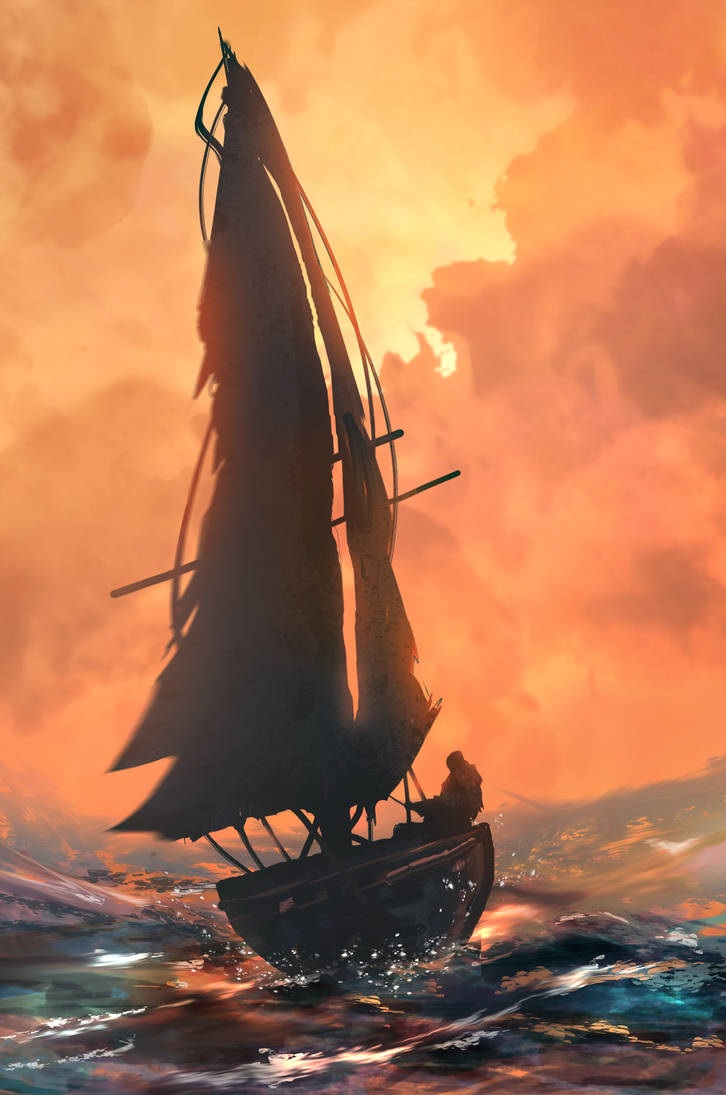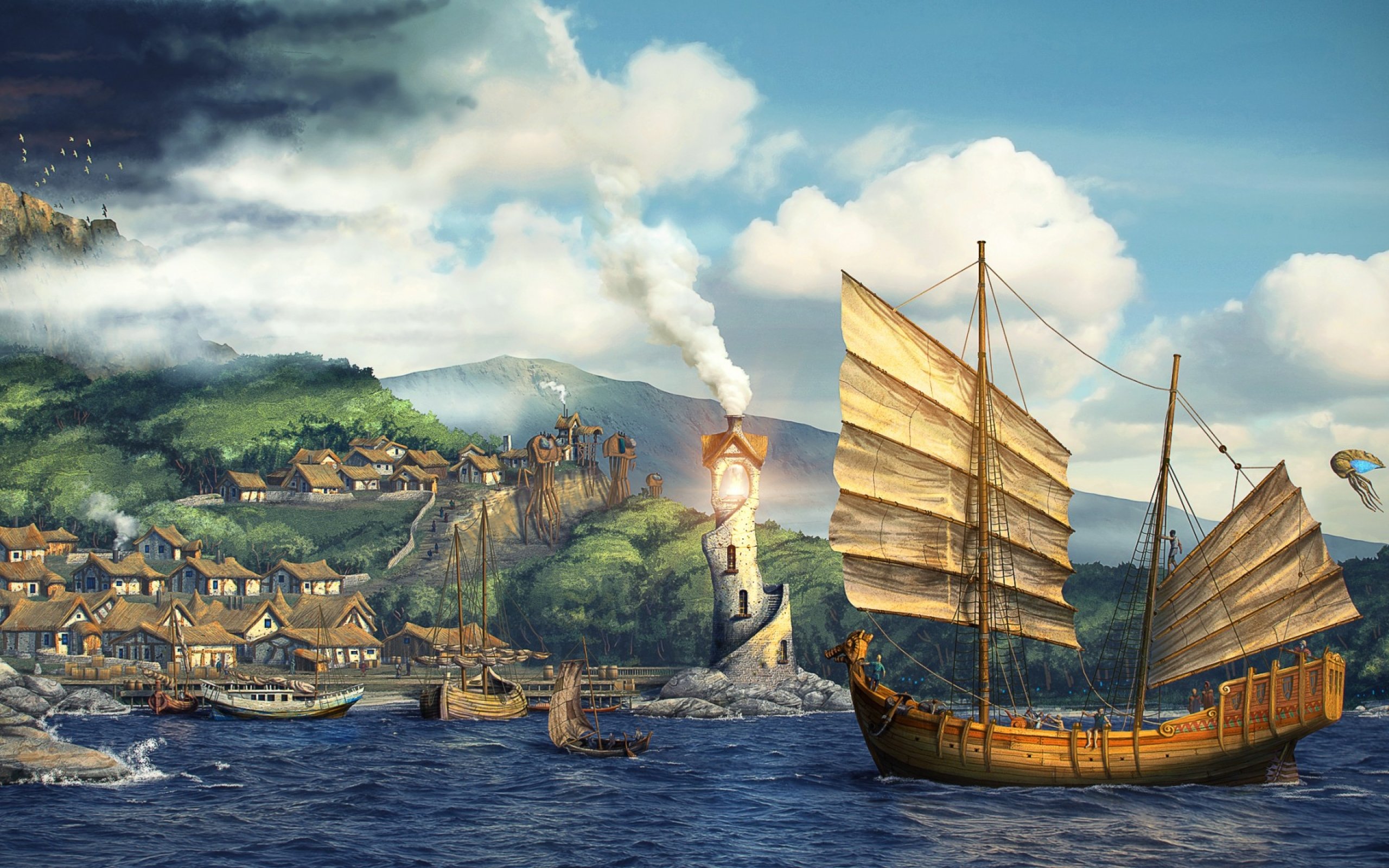Sailing (sage ability)
Sailing is an amateur-status sage ability in the studies of Athletics, Beachcomber and Oceanography, enabling the character to pilot a sailed vessel that's being driven forward by the wind. As the craft moves across the water's surface, the sailor guides the vessel on its chosen course by means of the sail's attitude, the ship's rudder and with considerable experience when considering wind and water. The vessel's chosen course is a matter for another skill, navigation, which sailor's possess in small degree, so long as they remain within sight of land.
Characters without any skill at sailing are called "landsfolk." These persons are unable to contribute in any productive way towards the operation of a vessel, even under direction. However, they are able to bail or work a ship's pump, to clear water from the ship; they can help in putting out fires, in cleaning and painting, so long as these things are directed by someone with able status, that being a person with 10 or more points of knowledge in the studies described above. If left to themselves, landsfolk are at the sea's mercy; the ship or boat they're on can only drift. Landsfolk can usually handle oars in a rowboat, but if the wind is stronger than a gentle breeze, rowing alone cannot manage the craft.
Contents
Training a Sailor
A character's sailing sage ability status describes what the sailor may do effectively aboard a sailing vessel. The ability also applies to the conditions at which a sailor is potentially overwhelmed, and the likelihood and consequences of failure the sailor experiences when pitted against that menace.
Gaining Sailing Knowledge
Landsmen may be trained to reach a trained status, provided the teacher has either an authority/master status in training or has both an able status in sailing and the sage ability, give secondary skill.
If schooled, landsfolk may, after 17 hours of time spent sailing and working aboard ship, while being instructed, make an attempt to gain 1 point of sailing ability. This requires a successful intelligence check & wisdom check. If either check fails, another 17 hours of training must follow before the attempt to learn a point can be made again. No more than three successes are possible per month of training, while a maximum of 9 points may be gained (1 less than is needed for amateur status), by means of this level of instruction.
To surpass a trained status, the instructor must have both an authority-status ability in sailing and the pass along ability sage ability.
Trained
Trained sailors are those with 1-9 knowledge points. Characters of this status level have insufficient skill to command a sailing vessel of any size, but may be counted as crew toward the number required to operate the vessel. Trained crew are counted as "ordinary seamen," having between 1 and 2 years experience at sea. They are automatically successful as crewmen in weather up to and including force 5 winds (a "fresh breeze," up to 21 knots).
When acting as crew in heavier weather than force 5 winds, the sailor must roll a seamanship check, and if failed, roll on the Crew Fault table. A seamanship check is expressed as a percentage equal to 7 per point of dexterity above 10, plus sailing knowledge, plus the captain's sailing knowledge. A further modifier is applied when the wind force exceeds 5; this modifier equals the wind force -1, squared: (WF-1)2.
| Roll | Error | Result |
|---|---|---|
| 01 | fall from rigging | fall from d6x10 feet, limited by height of mast; 1 in 6 falls will land in the sea |
| 02-07 | loose cargo | improperly tied load gets loose and causes 20-120 g.p. worth of goods that needs replacement; if no load that needs tying-down, treat as loose gear |
| 07-16 | loose gear | take 2-5 damage from being struck; ship makes save vs. normal blow or loses 3-18 g.p. of gear that needs replacing |
| 17-40 | rigging failure | lose ½ knot headway & make seamanship check to maneuver |
| 41-55 | sail failure | clew/head rips out due to slow response to command; lose ½ knot headway & drift for ½ hour |
| 56-58 | sail lost | tattered due to poor control; permanent loss of 1 knot headway & 1 grade of maneuverability |
| 59-60 | struck by rigging | take 2-12 damage; save vs. paralyzation or suffer 2-5 injury & disabled until healed |
| 61-99 | stumble | take 1-2 damage from knock |
| 00 | swept overboard | all crew aboard ship rolls 1d6; if ABS rolls a 1 or a 2, and no authority/master rolls 1-4 in 6, then no one sees it happen |
- For example, a "trained" sailor with 17 dexterity and 4 sailing knowledge, with a captain that has 16 knowledge, has a base seamanship rating of 69%: (17-10)x7 + (4) + (16). A "strong wind" (force-6) would subtract 25 from the total (=44%). A "near gale" would subtract 36 (=33%) and a "gale" would subtract 49 (=20%).
Trained sailors are not able to teach others to sail.
Amateur/Able
Characters with amateur-status, or Able-bodied seamen (ABS), have complete knowledge of how a sailing vessel is intended to work and how to manage up to 3 crew competently. Able sailors are capable of all of the tasks required to operate a vessel of any size, commonly summarized as able to “hand, reef, and steer.”
Persons with this status of ability will not be able to teach sailors without the sage ability, give secondary skill.
ABS Acting as Crew
As crew, able sailors are automatically successful in conditions up to and including force 7 winds (a "near gale," up to 33 knots).
When acting as a crew in heavier weather than force 7 winds, able sailors calculate their seamanship check differently from trained crew. An able sailor's percentage equals 9 per point of dexterity above 8, plus sailing knowledge, plus the captain's sailing knowledge. The modifier for wind force greater than 7 is adjusted: (WF-3)2.
- For example, an ABS with a 12 dexterity and 16 sailor knowledge, with a captain that has 45 knowledge, has a base seamanship rating of 97%: (12-8)x9 + (16) + (45). A "gale" (force 8) would subtract 25 (=72%); a "strong gale" (force 9) subtracts 36 (=61%); and a "storm" (force 10) subtracts 49 (=48%). All failures are rolled on the Crew Fault table.
ABS as Master
Able sailors will not be able to master boats that ask for more than 4 crew members by themselves, as these will require at least one sailor with authority/master status. However, able sailors will be able to command any lesser boat by themselves if necessary in up to force 5 winds (a "fresh breeze," up to 21 knots). In worse conditions, able sailors acting as masters must make a seamanship check every hour.
When acting as a master in heavier weather than force 5 winds, able sailors calculate their seamanship check differently again. An ABS master's percentage equals 9 per point of wisdom, not dexterity, above 8, plus sailing knowledge, plus the average knowledge of the crew on duty. When calculating the average knowledge of any crew, the minimum divisor must be 3. The modifier for wind force greater than 5 is adjusted: (WF-2)2.
| Roll | Error | Result |
|---|---|---|
| 01-02 | broach | roll seamanship check again or founder |
| 03-17 | crew failure | roll on Crew Fault table and apply effect to random crewmember |
| 18-20 | dismasted | roll seamanship check again or broken spar holes the hull, causing sinking; lose 3 grades of maneuverability until cleared (3-18 minutes) |
| 21-26 | helm lost | ship adrift; check seamanship every minute until it is jury-rigged (4-32 minutes); lose 2 grades of maneuverability |
| 27-51 | loose gear | take 2-5 damage from being struck; ship makes save vs. normal blow or loses 5-30 g.p. of gear that needs replacing |
| 52-60 | sail lost | destroyed due to poor command; permanent loss of 1 knot headway & 1 grade of maneuverability |
| 61-00 | stumble | take 1-2 damage from knock |
- For example, an ABS master with a 17 wisdom and 16 sailor knowledge, commanding a crew with an average of 3 sailing knowledge, has a base seamanship rating of 100% (17-8)x9 + (16) + (3). A "strong wind" (force-6) would subtract 25 from the total (=75%). A "near gale" would subtract 36 (=64%) and a "gale" would subtract 49 (=51%). All failures are rolled on the Command Fault Table.
Authority/Master
Also called a shipmaster, authority status does not convey a stepping-stone towards competency, but rather it describes the highest accomplishment that most sailors will achieve in their lifetime. Aboard a large vessel, authority conveys the scale between a lieutenant with 30-34 points of knowledge and a full captain of the line with 55-59 points. Authorities are fully versed with the action of the ship, and learn through opportunity, not training, to take command when it is thrust upon them. Most are not daring, brilliant or the stuff of legend, but they do have proficiency at being efficient and capable shipmasters.
Command
An authority with less than 45 knowledge points can command any ship whose crew numbers up to ½ of their knowledge points. Those with more 45 or more knowledge can command a ship of any size. This ability to command includes a natural instinct for making subordinates conform and obey, so long as the character does not outwardly act against their general goodwill or outside the normal expectations that commanders would have of their crews.
The shipmaster is able to use a sextant, and therefore to determine their accurate location upon the earth; provided that they have a proper chart of the sea, they will be able to guide a vessel through unfamiliar waters to an intended destination, though they may never have been to that place before. This faculty does not grant the full skill of either navigation or celestial navigation, but it does complement the shipmaster's sailing ability.
Weather Intuition
The shipmaster is able to understand the weather intuitively in one peculiar regard, for they possess a "sixth sense" for the appearance of bad weather (a wind force of greater than 7) that is sure to come to the fore within the next 1 to 3 hours. This foresight will not describe the exact conditions, name the direction of the wind, the amount of rain or the length of time that it will last — or even the force of the wind that is coming. Yet the intuition will unerringly recognize that "something" is coming, that threatens the ship and its crew. The shipmaster will always possess this foreknowledge when awake.
Seamanship
As an authority, the character's skill as a crewmember improves with accumulated knowledge points, but that is all. Their skill as a master is enhanced, however, so that they are now able to command with excellence in up to force 6 winds (a "strong breeze," up to 27 knots). Their seamanship check is calculated as it would be for an able-bodied seaman acting as master, except that the modifier for a wind force greater than 6 is adjusted: (WF-3)2.
This post includes significant contributions from Sterling Blake. Thank you Sterling.

